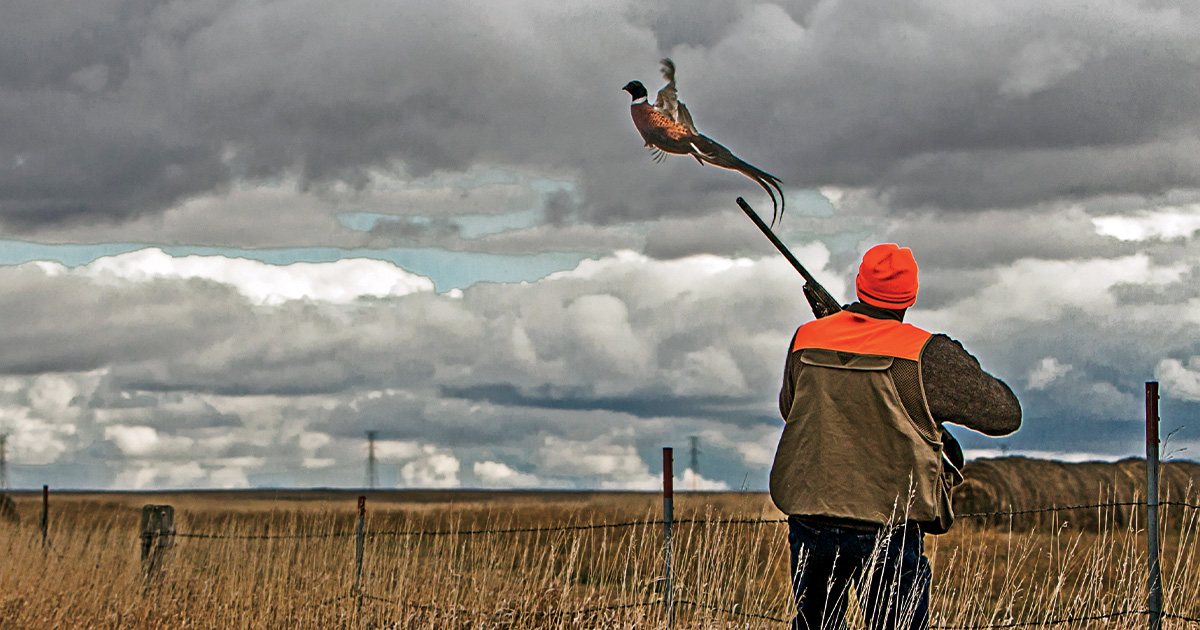Shotgunning: A Primer for Pheasants
Everything a waterfowler needs to know before heading to the uplands
Everything a waterfowler needs to know before heading to the uplands


Pheasants flush without warning and present a variety of going-away and quartering shots that are seldom encountered in the duck blind. Shooting trap is perhaps the best preparation for first-time pheasant hunters.
If you’re a duck hunter embarking on your first pheasant hunt, get ready. The startling flush of a cock pheasant, the fast exit, and the going-away and quartering shot angles can rattle even experienced waterfowlers. Here’s how to be as prepared as possible.
You already own a pheasant gun. It’s your duck gun. Twelve-gauge shotguns are the best choice, but 16s and 20s aren’t far behind. Even a 28-gauge can be a good option if you’re willing to limit your shooting distances. The majority of pheasants fall within 25 yards of the shooter. For most situations, a gun choked improved cylinder, light modified, or modified is enough.
A lot of the good places to hunt in the Dakotas, including federal Waterfowl Production Areas, require nontoxic shot. Steel 2s and 3s, bismuth 5s, and Hevi-XII 6s are good nontoxic choices. If you’re elsewhere shooting lead, go with 5s or 6s. A 12-gauge, 1 1/4-ounce, 1,300 fps lead or bismuth load, or a 1,400 fps steel load, has plenty of punch and not too much recoil.
Before your hunt, practice mounting an unloaded gun at home. Choose an object on the wall and keep your eyes on it as you move the gun toward your face. The idea is to bring the gun to your eye, not your eye to the gun. When you can move the muzzle toward the bird while raising the gun, you’ve replaced three separate steps (shoulder the gun, put your head down, swing) with one compact motion.
Trapshooting, with its random going-away angles, is excellent practice. You have to read the angle first, then move the gun through the target and shoot. While shooting formal trap helps, the best preparation is to get a trap field to yourself, stand a few steps behind the house, and shoot from a low-gun start. You can also set up a similar scenario with an electric trap, especially if you have a remote, which will allow you to trigger a trap set in front of the shooter.
Unlike ducks, which you can usually see coming, pheasants give you little or no warning prior to the shot. The better you react to the flush, and the more comfortable you are with going-away shots, the more birds you’ll bag. Your gun mount needs to be efficient and not rushed.
When you hear the clatter of wings or see a bird, turn your body toward it. At the same time, bring your gun to a ready position with the muzzle in the direction of the bird and the butt held lightly under your armpit. If it’s a rooster (wild pheasant hens are illegal to shoot in most of the United States), and if it’s your shot, push the muzzle toward the bird while bringing the comb to your face and flicking the safety off as the gun comes up. Be sure to push the gun out and away from you so you don’t snag it on your clothing.
Successful pheasant shooting begins with an alert frame of mind. If you slog along looking at your toes, you’ll never react in time. You don’t have to be hyper-vigilant, but you do have to keep your eyes up and believe that you could see a pheasant at any moment, because you might.
Pheasants are big birds with long, distracting tails, and the temptation is to shoot at the whole bird. Take an instant to find the white neck ring, red eye patch, or white stripes on the bird’s head. The tighter your focus on the front end of the bird, the more likely you are to hit the vitals.
Some shots at pheasants are relatively close. To avoid ruining any meat, sometimes you’ll have to wait for a bird to get out to 20 or 25 yards. Pass up shots at birds going straightaway at more than 35 yards. At that distance, you’re likely to break a wing at best, and crippled pheasants can run or burrow into long grass or cattails where sometimes even good dogs can’t find them. Crossing pheasants present a lot of vitals. If you have the necessary skill, a 30- to 35-yard crosser can be a good shot.
Ducks Unlimited uses cookies to enhance your browsing experience, optimize site functionality, analyze traffic, and deliver personalized advertising through third parties. By continuing to use this site, you agree to our use of cookies. View Privacy Policy